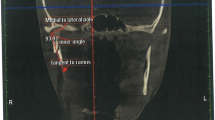Abstract
To evaluate the management of sub-condylar and angle of mandible fracture by a trans-buccal trocar along with an intra-oral approach. Study parameters included were assessment of adequacy of anatomical repositioning, fixation and stability of fracture site by radiographs, pre and post – operative occlusion by photographs. Evaluation of anatomical repositioning was done with fracture gap measurement on orthopantomogram after 6 months by applying paired student’s T test. In mandibular angle fracture, pre- operatively, the mean of anatomical repositioning fracture gap measurement on orthopantomogram was 4.06 mm with a standard deviation of 1.42 mm and 6 months post-operatively, the mean was 0.5 mm with a standard deviation of 0.32 mm. The P value was < 0.00001, which shows a very high significant. In sub-condylar fractures, pre- operatively, the mean of anatomical repositioning fracture gap measurement on orthopantomogram was 6.77 mm with a standard deviation of 3.54 mm and 6 months post-operatively, the mean was 1.57 mm with a standard deviation of 2.37 mm. As the sample size was small, P value could not be calculated. The use of the trans-buccal trocar provides adequate anatomical repositioning, fixation, stability, occlusion and good accessibility during placement of plate and screws.



Similar content being viewed by others
References
Saito DM, Murr AH (2008) Internal fixation of mandibular angle fractures with the Champy technique. Oper Techn Otolaryng Head Neck Surg 19(2):123–706
Sehgal S, Ramanujam L, Prasad K, Krishnappa R (2014) Three-dimensional v/s standard titanium miniplate fixation in the management of mandibular fractures: a clinical study. J Cranio Max Fac Surg 42(7):1292–1299. https://doi.org/10.1016/j.jcms.2014.03.012
Jensen T, Jensen J, Norbolt SE, Dahl M, Svensson LLHP (2006) Open Reduction and rigid internal fixation of mandibular condylar fractures by an intraoral approach: A long –term study follow-up study of 15 patients. J Oral Maxillo Fac Surg 64:1771–1779
You HJ, Moon KC, Yoon BI, Park SH (2016) Clinical and radiological outcomes of transoral endoscope-assisted treatment of mandibular condylar fractures. Int J Oral Maxillo Fac Surg 45:284–291
Toma VS, Mathog RH, Toma RS, Meleca RJ (2003) Transoral versus extraoral reduction of mandible fractures: a comparison rates and other factors. Otolaryngol Head Neck Surg 128:215–219
Dierks EJ, Dallas (1987) Transoral approach to fractures of mandible. Laryngoscope. https://doi.org/10.1288/00005537-198701000-00002
Beza SA, Attia S, Ellis E, Omara L (2016) A comparative study of transbuccal and extraoral approaches in the management of Mandibular angle fractures: a systemic review. Open Access J Med Sci 4(3):482–488.
Jeter TS, Sickels JV, Gary J, Nishioka (1987) Intraoral open reduction with rigid internal fixation of mandibular subcondylar fractures. J Oral Maxillo Fac Surg 46:1113–1116
Wakuloba G, Mahallawy A, Ragab H (2015) Evaluation of dynamic compression miniplates in treatment of mandibular angle fractures using trocar. Alexandria Dent J 40:86–93
Schaaf H, Kaubruegge S, Streckbein P, Wilbrand JF, Kerkmann H, Howaldt HP (2011) Comparison of miniplate versus lag-screw osteosynthesis for fractures of the mandibular angle. Oral Surg Oral Med Oral Pathol Oral Radiol Endod 111:34–40
Wan K, Williamson RA, Gebauer D, Hird K (2012) Open reduction and internal fixation of mandibular angle fractures: does the transbuccal technique produce fewer complications after treatment than the transoraltechnique. J Oral Maxillo Fac Surg 70:2620–2628.
Malhotra A, Borle R, Bhola N, Mundada B (2014) Comparison of post operative outcomes in mandibular condylar fractures treated with single versus double non-compression mini plates. IOSR J Dent Med Sci 13(10):89–93
Choi BH, Yi CK, Yoo JH (2001) Clinical evaluation of 3 types of plate osteosynthesis for fixation of condylar neck fractures. J Oral Maxillo Fac Surg 59:734–737.
Uglesic V, Virag M, Aljinovic N, Macan D (1993) Evaluation of mandibular fracture treatment. J Cranio Maxillofacial Surg 21:251–257
Kumar GBA, Dhupar V, Akkara F, Kumar SP (2015) Patterns of maxillofacial fractures in Goa. J Maxillofac Oral Surg 14(2):138–141
Venugopal MGM, Sinha R, Menon PS, Chattopadhyay PK, Chowdhury SKR (2010) Fractures in the maxillofacial region: a four year retrospective study. MJAFI 66:14–17
Vyas A, Mazumdar U, Khan F, Mehra M, Parihar L, Purohit C (2014) A study of mandibular fractures over a 5-year period of time: a retrospective study. Contemporary Clin Dent 5(4):452–455.
Natu SS, Pradhan H, Gupta H, Alam S, Gupta S, Pradhan R et al (2012) An epidemiological study on pattern and incidence of mandibular fractures. Plast Surg Int. https://doi.org/10.1155/2012/834364.
Rai A (2012) A comparison of single versus double noncompression miniplates in the management of subcondylar fracture of the mandible. Ann Maxillo Fac Surg 2(2):141–145.
Spiessl B, Schroll K. Gelenkfortsatz- und Gelenkkoepfchenfrakturen. In: Nigst H, editor SpezielleFrakturen- und Luxationslehre Bd. I/I. Stuttgart, Germany: Thieme. 1972.
Santler G, Kiircher H, Ruda FC (1999) KGle E: Fractures of the condylar surgical versus nonsurgical. J Oral Maxillofac Surg 57:392–397
Murr AH (2005) Mandibular angle fractures and noncompression plating techniques. Arch Otolaryngol Head Neck Surg 131:166–168
Ellis E 3rd, Ghali GE (1991) Lag screw fixation of mandibular angle fractures. J Oral Maxillo Fac Surg 49:234–243
Claes L, Eckert-Hubner K, Augat P (2003) The fracture gap size influences the local vascularization and tissue differentiation in callus healing. Langenbecks Arch Surg 388(5):316–322
Kurtadikar K, Singhvi N, Shetty JN, Shetty O, Islam M et al (2015) Evaluation of mechanical resistance after fixation of mandibular condylar fracture with single and double miniplates: a comparative in vitro study. J Maxillo Fac Oral Surg 14(2):441–447.
Author information
Authors and Affiliations
Corresponding author
Additional information
Publisher's Note
Springer Nature remains neutral with regard to jurisdictional claims in published maps and institutional affiliations.
Rights and permissions
About this article
Cite this article
Krishnan Kutty, D., Hallur, N., Siddiqa, A. et al. Management of Sub-Condylar and Angle of Mandible Fracture by a Trans-Buccal Trocar Along With an Intra-Oral Approach. Indian J Otolaryngol Head Neck Surg 72, 538–544 (2020). https://doi.org/10.1007/s12070-020-02058-7
Received:
Accepted:
Published:
Issue Date:
DOI: https://doi.org/10.1007/s12070-020-02058-7




